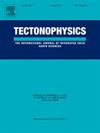Tectonic tremor source depths in relation to subduction zone structure in northern Cascadia
IF 2.6
3区 地球科学
Q2 GEOCHEMISTRY & GEOPHYSICS
引用次数: 0
Abstract
Tectonic tremor occurs in frequent episodes throughout northern Cascadia, typically during slow slip events deep in the subduction zone. Adequately constraining tremor source depths is a challenge associated with using low-amplitude, emergent waveforms. In this study, we present a tremor catalogue with improved depth resolution computed using the differential traveltime Bayesian inversion method, where tremor sources are represented as 3D probability distributions. We examine tremor source depths throughout northern Cascadia in relation to low-frequency earthquakes (LFEs) and key features in the subduction zone imaged using receiver-function analysis. We show that the highest concentrations of tremor are 5–10 km shallower than LFEs everywhere in northern Cascadia. We also find that neither tremor nor LFEs localize consistently to the top of the oceanic crust, which is often interpreted to represent the subduction fault. Rather, tremor localizes throughout a volume corresponding to the deep accretionary complex at depths deeper than 15 km. Where the accretionary complex appears to be vertically-truncated by forearc terranes, such as the Olympic Accretionary Complex in Washington, the tremor depth distribution is similarly vertically restricted. Depth trends of tremor and LFEs may indicate deformation within and above the downgoing plate that is not represented in current models of the subduction zone. We suggest that tremor-generating processes may involve multiple mechanisms that are partly dependent on their distance from the downgoing plate and occur within the compositionally- and structurally-heterogeneous mélange of the deep accretionary complex.
卡斯卡迪亚北部构造震源深度与俯冲带结构的关系
整个北卡斯卡迪亚频繁发生构造震颤,特别是在俯冲带深处的慢滑事件期间。充分限制震源深度是与使用低振幅、紧急波形相关的挑战。在这项研究中,我们提出了一个具有改进深度分辨率的地震目录,使用差分走时贝叶斯反演方法计算,其中地震源表示为三维概率分布。我们研究了整个北卡斯卡迪亚的震源深度与低频地震(LFEs)的关系,并使用接收函数分析成像俯冲带的主要特征。我们表明,在卡斯卡迪亚北部的任何地方,地震的最高集中地都比lfe浅5-10公里。我们还发现,无论是震颤还是生命周期都不一致地定位于洋壳顶部,这通常被解释为代表俯冲断层。相反,震颤发生在深度超过15公里的深吸积复合体对应的整个体积内。当增生复合体在垂直方向上似乎被前弧地形截断时,例如华盛顿的奥林匹克增生复合体,地震深度分布在垂直方向上也同样受到限制。地震的深度趋势和生命周期波动可能表明下行板块内部和上方的变形,这在当前的俯冲带模型中没有表现出来。我们认为,地震产生过程可能涉及多种机制,这些机制部分取决于它们与下行板块的距离,并发生在深部增生复合体的成分和结构不均匀的范围内。
本文章由计算机程序翻译,如有差异,请以英文原文为准。
求助全文
约1分钟内获得全文
求助全文
来源期刊

Tectonophysics
地学-地球化学与地球物理
CiteScore
4.90
自引率
6.90%
发文量
300
审稿时长
6 months
期刊介绍:
The prime focus of Tectonophysics will be high-impact original research and reviews in the fields of kinematics, structure, composition, and dynamics of the solid arth at all scales. Tectonophysics particularly encourages submission of papers based on the integration of a multitude of geophysical, geological, geochemical, geodynamic, and geotectonic methods
 求助内容:
求助内容: 应助结果提醒方式:
应助结果提醒方式:


